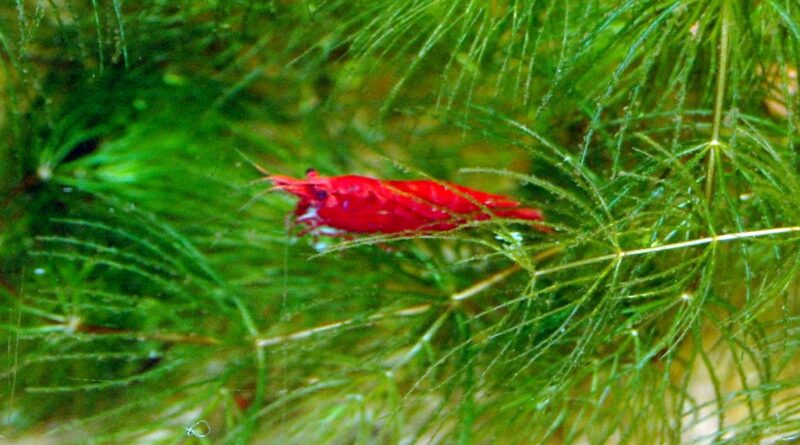How to Care for Freshwater Shrimp: Tank Setup, Parameters, and Tips
Introduction
Freshwater shrimp has become a favourite among aquarists of all experience levels—and it’s easy to see why. These fascinating invertebrates bring vibrant colour, delicate movement, and excellent tank-cleaning abilities to any aquarium. Whether you’re setting up your very first shrimp tank or looking to add a peaceful and low-maintenance cleanup crew to your planted aquarium, shrimp can be a rewarding addition.
From the bright red cherry shrimp to the ever-popular Amano shrimp, there’s a wide variety of species suited for freshwater tanks. These small creatures thrive in stable, well-established aquariums and can coexist peacefully with many other fish and invertebrates, making them ideal for community setups. On top of their visual appeal, they also play an essential role in tank health by feeding on algae, biofilm, and detritus.
In this comprehensive guide, you’ll learn everything you need to know about freshwater shrimp care—from choosing the right species and setting up their habitat to maintaining ideal water parameters and selecting compatible tank mates. Whether you’re a beginner building your first shrimp tank or an experienced hobbyist looking to improve your care routine, this article covers all the essentials to help your shrimp thrive.
Why Freshwater Shrimp Are Great for Aquariums
Freshwater shrimp aren’t just fascinating to watch—they bring real benefits to your aquarium. Whether you’re setting up a shrimp-only tank or adding them to a peaceful community tank, these tiny invertebrates punch well above their weight.
🟢 Key Benefits of Freshwater Shrimp:
- Algae Control
Many popular shrimp species, such as Amano shrimp, are voracious algae eaters. They help manage soft green algae and keep surfaces clean, especially in planted tanks. - Detritus Removal
Shrimp act as natural tank janitors. They clean up leftover fish food, decaying plant matter, and biofilm, reducing the risk of water quality issues caused by waste buildup. - Interesting and Peaceful Behaviour
Unlike many fish, shrimp display unique behaviours like constant grazing, fan-feeding (in filter shrimp), and moulting. Their peaceful nature makes them compatible with small community setups. - Safe for Planted Tanks
Shrimp won’t uproot or damage plants, making them perfect for aquascapes or nature-style tanks. In fact, their constant grazing helps prevent algae from smothering delicate plant leaves. - Low Bioload
Shrimp have a minimal impact on your tank’s nitrogen cycle, making them ideal for nano aquariums when stocking density is a concern.
With proper freshwater shrimp care, these invertebrates not only thrive but also contribute significantly to the health and balance of your aquarium ecosystem.
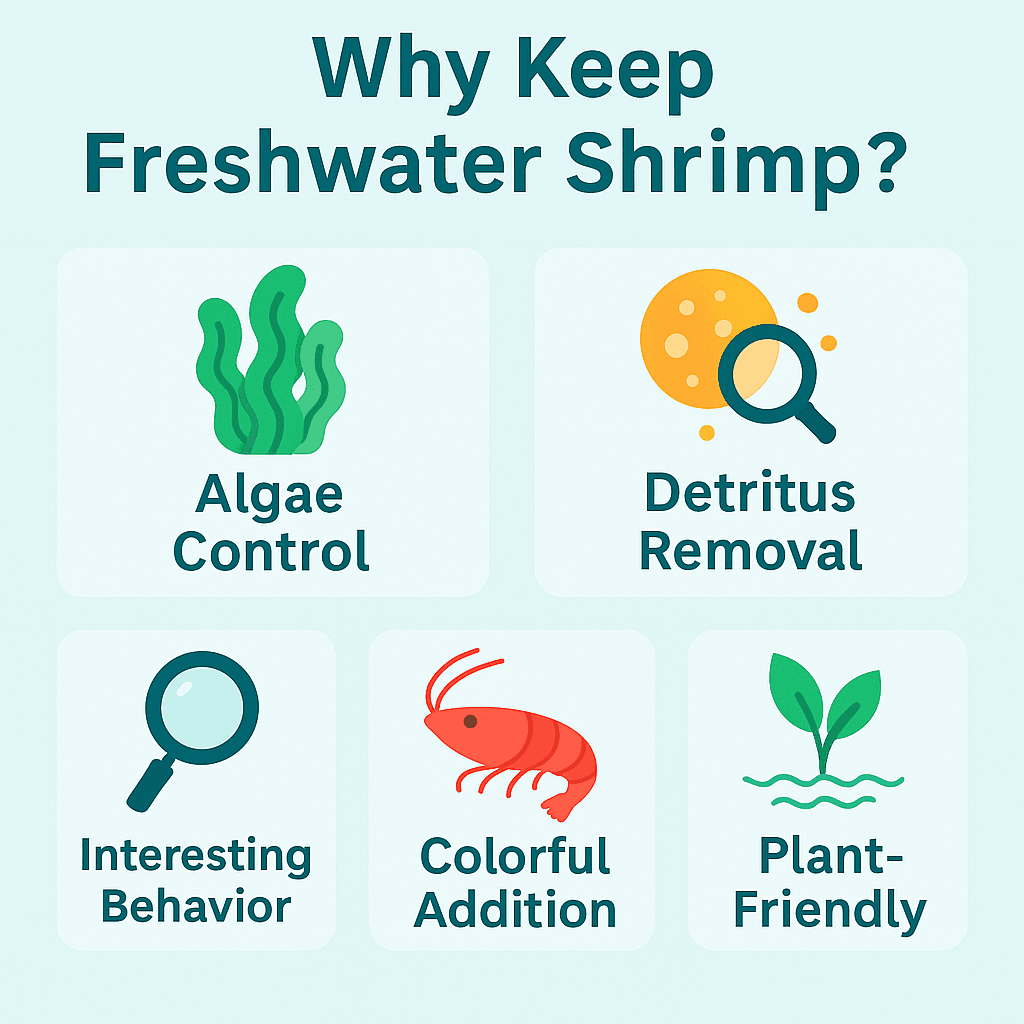
Tank Setup: Create a Shrimp-Friendly Environment
A successful shrimp tank starts with the right setup, and stability is key. Shrimp are especially sensitive to poor water quality, so setting up a well-cycled and mature tank is critical. Avoid placing shrimp into a freshly started aquarium, as even small ammonia or nitrite spikes can be fatal.
🔹 Minimum Tank Size
- Ideal size: A 10-gallon (38 L) shrimp tank offers better stability and more room for a colony to grow.
- Nano tanks (5 gallons/20 L or less): These can work, but they demand more frequent monitoring and maintenance. Beginners are encouraged to start with something larger.
- Lids are recommended: Shrimp can climb out of open tanks, especially Amanos. A lid helps prevent accidental escapes and reduces evaporation.
🔹 Filtration and Water Flow
- Use a sponge filter or place a pre-filter sponge over the intake of a hang-on-back or canister filter. This prevents shrimp—especially babies—from being sucked in.
- Keep the water flow gentle. Shrimp prefer calm waters where food and biofilm settle onto surfaces. A strong current can stress them or prevent them from foraging properly.
🔹 Substrate and Decor
- Substrate: Choose a dark, fine-grained substrate like aquarium soil or black sand—it enhances the shrimp’s colouration and mimics their natural habitat.
- Hiding spots: Provide plenty of caves, rocks, shrimp tubes, and pieces of Cholla wood or driftwood.
- Aquascaping: Incorporate shrimp-friendly plants like mosses (e.g., Java moss), floating plants, and dense stems. These surfaces promote biofilm growth and offer shelter.
🔹 Lighting and Temperature Considerations
- Lighting: Moderate lighting is sufficient. Bright lighting can stress shrimp if not paired with adequate hiding spaces.
- Temperature control: In warmer climates, ensure the tank doesn’t overheat in summer. In cooler regions, use a reliable heater to maintain shrimp-safe temperatures year-round.
Need help setting up your first tank? Check out our full guide on How to Setup Your First Freshwater Fish Tank.
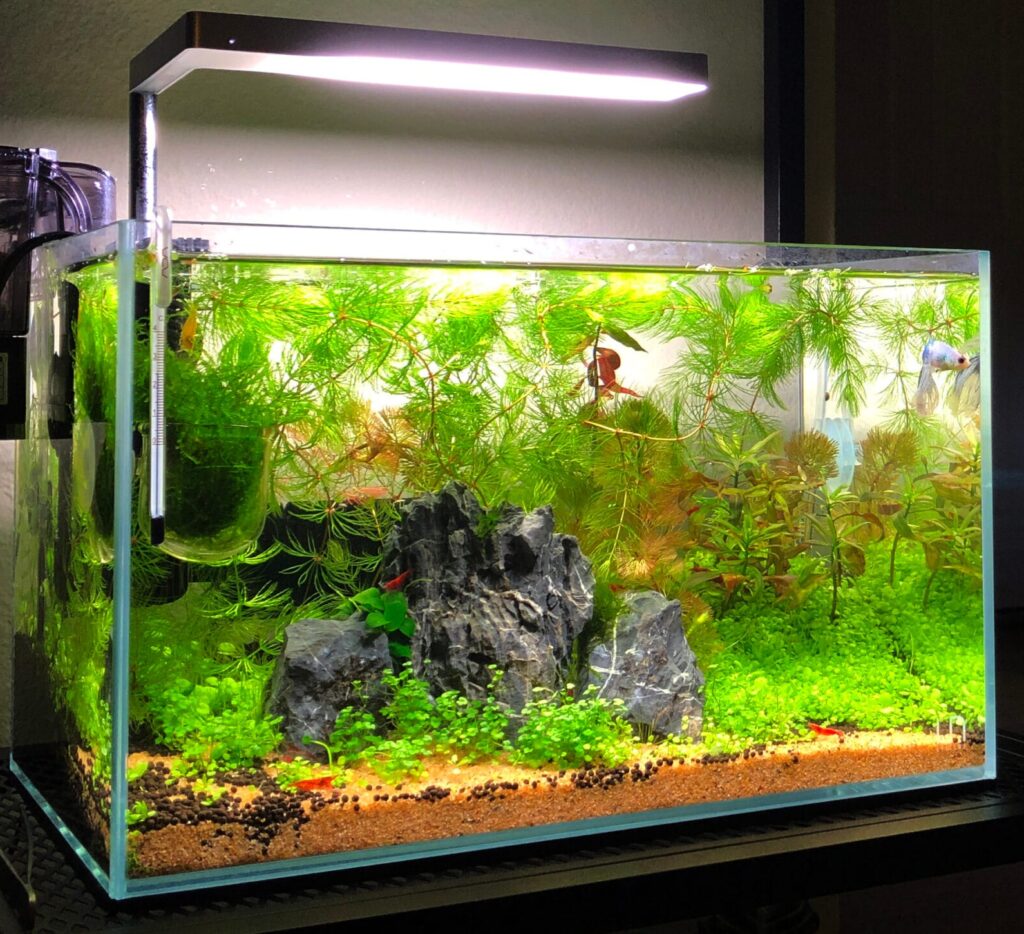
Water Parameters for Healthy Shrimp
Stable, clean water is the single most important factor in shrimp health. While some species are more forgiving than others, most freshwater shrimp, especially Caridina types, are highly sensitive to fluctuating conditions. It’s critical to set up a fully cycled, well-established tank before introducing any shrimp.
A sudden shift in parameters like pH, GH, or temperature can cause moulting issues, stress, or even death. To avoid this, invest in a good water test kit and check parameters weekly, especially in nano tanks where conditions can change rapidly.
🔹 Ideal Water Parameters for Freshwater Shrimp
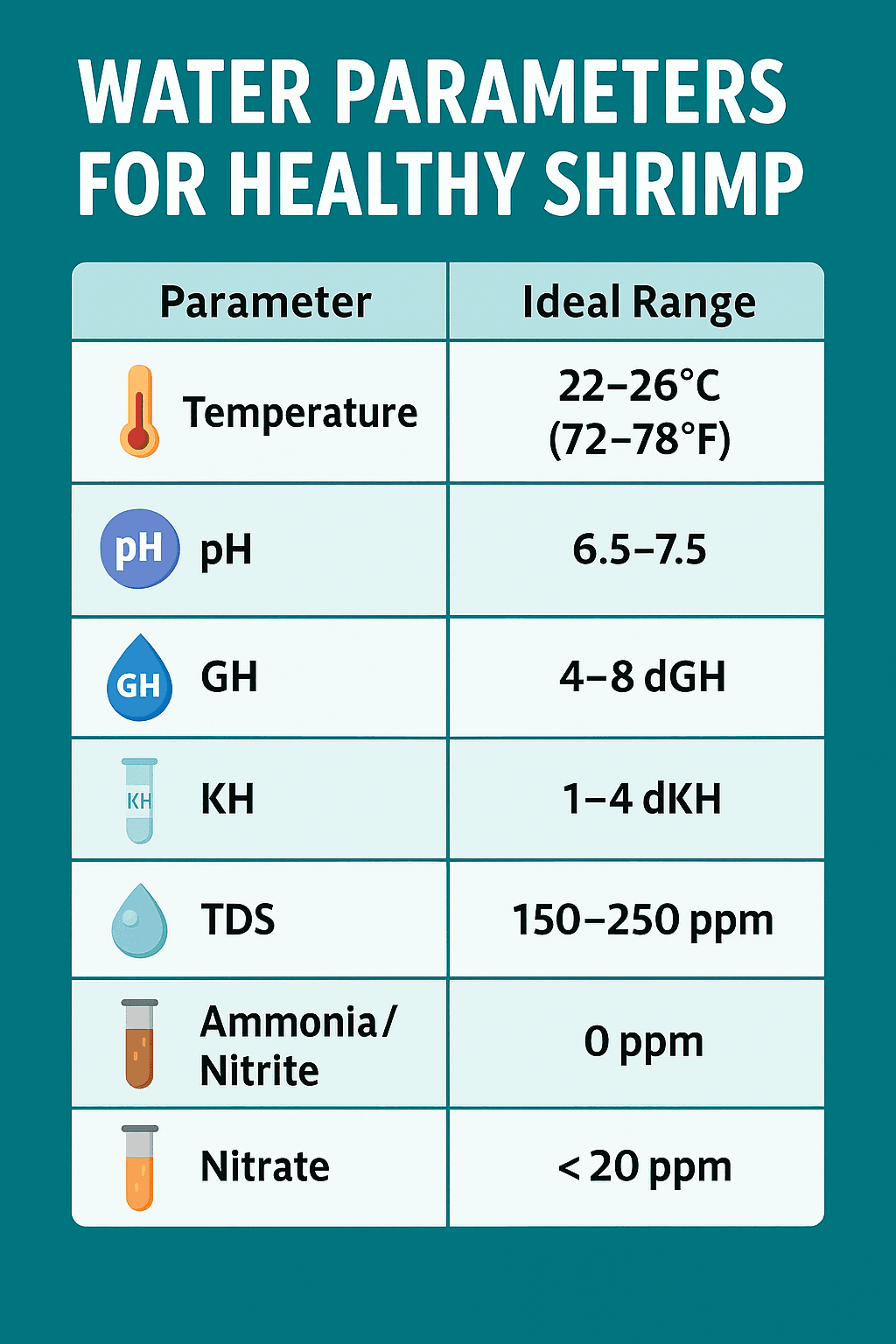
🔹 Tools and Tips for Testing
- Use liquid test kits for ammonia, nitrite, nitrate, pH, GH, and KH. Brands like API or JBL are common.
- A TDS meter is essential for shrimp-keepers—it helps track overall water purity and mineral content.
- Monitor GH and KH if you use reverse osmosis (RO/DI) water, and remineralise appropriately using shrimp-specific products like Salty Shrimp GH+.
- Avoid fluctuations from frequent large water changes; instead, perform small 10–20% changes weekly with pre-conditioned water.
🔹 Species-Specific Notes
- Neocaridina shrimp (e.g., cherry shrimp) are hardy and adaptable to a broader range of parameters.
- Caridina shrimp (e.g., crystal red shrimp, Taiwan bee shrimp) need soft, slightly acidic water and tighter mineral control.
💡 Pro Tip: If you’re unsure where to start, begin with Neocaridina varieties. They’re perfect for beginners and tolerate common tap water with minimal adjustments.
For a deeper dive into aquarium water chemistry, see our Understanding Aquarium Water Parameters guide.
Feeding Your Freshwater Shrimp
Feeding shrimp may seem simple, but providing a balanced, varied diet is key to their health, color, and successful breeding. Shrimp are natural scavengers and omnivorous detritivores, meaning they feed on plant matter, microorganisms, and decaying organic matter.
In a well-established planted tank, biofilm, algae, and decaying plant matter will serve as a primary natural food source. However, supplementation is essential, especially in newer tanks or higher-density shrimp colonies.
🔹 What to Feed Shrimp
A complete shrimp diet should include:
Staple Food:
- High-quality shrimp pellets or wafers (e.g., GlasGarten, Borneowild, Shrimp King)
- Sinking algae wafers for continuous grazing
Vegetable Treats (once or twice weekly):
- Blanched zucchini, spinach, cucumber, or kale (remove uneaten portions after 2–3 hours)
Protein Supplements (1× per week):
- Bloodworms (frozen or freeze-dried)
- Baby brine shrimp
Natural Sources:
- Biofilm (forms on hardscape, glass, and plant surfaces)
- Indian almond leaves (Catappa) for softening water and promoting biofilm growth
- Cholla wood and mosses as grazing platforms
🔹 Feeding Schedule and Best Practices
- Feed 2–3 times per week in low-biofilm tanks; less if biofilm is abundant.
- Small portions only—shrimp have tiny stomachs and eat slowly.
- Remove leftovers after 2–3 hours to prevent ammonia spikes or planaria outbreaks.
- Use a feeding dish in bare or low-substrate tanks to keep the area clean and reduce food waste.
💡 Tip: Observe your shrimp during feeding. If food is ignored, they’re either full from biofilm or the parameters are off.
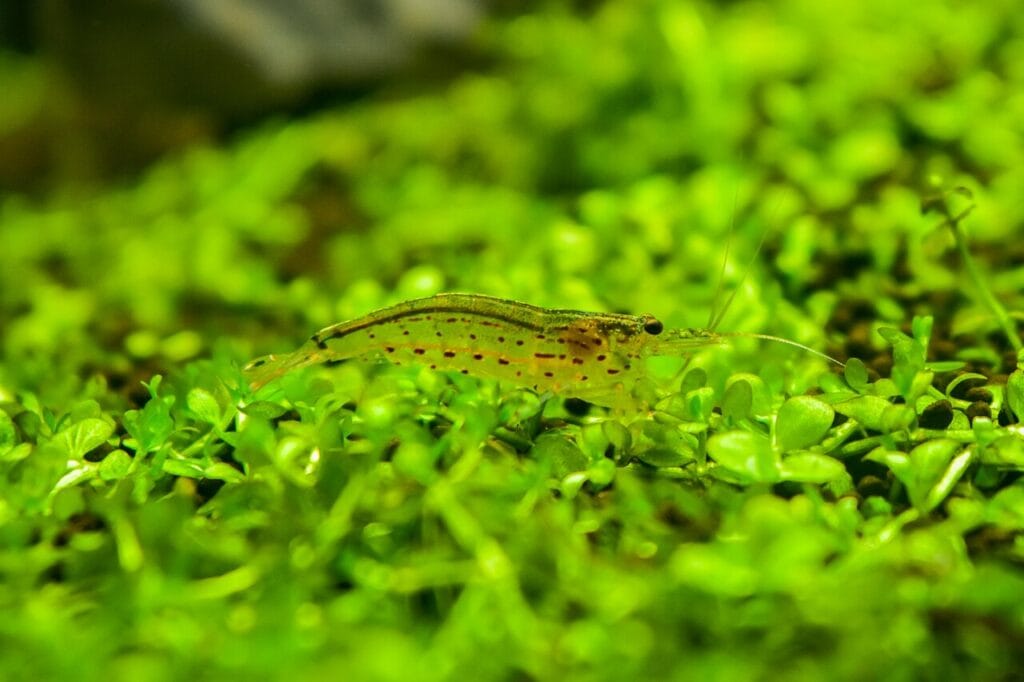
Safe Tank Mates for Freshwater Shrimp
Choosing the right tank mates is one of the most important decisions when keeping freshwater shrimp. While these small invertebrates are peaceful and non-aggressive, they are also vulnerable, especially to larger or curious fish that might see them as a snack.
Even so-called “peaceful” fish can become opportunistic predators if shrimp are small enough or newly moulted. For this reason, shrimp-only tanks are often ideal for beginners and breeders. However, with the right selection, community tanks can work beautifully with shrimp, provided they are well-planted and have enough hiding spots.
🔹 Ideal Companions for Freshwater Shrimp
Choose tank mates that are peaceful, small, and not aggressive eaters:
- Nano fish species:
- Ember Tetras
- Neon Tetras
- Green Neon Tetras
- Celestial Pearl Danios
- Pygmy Corydoras
- Chili Rasboras
- Endler’s Livebearers (avoid larger guppies)
- Otocinclus Catfish (algae eaters that ignore shrimp)
- Invertebrates:
- Nerite Snails
- Mystery Snails
- Rabbit Snails
- Malaysian Trumpet Snails
- Shrimp:
- Neocaridina and Caridina shrimp can be mixed in some cases, but check compatibility in terms of water parameters and avoid hybridisation if breeding.
🔸 Fish to Avoid with Shrimp
Some fish are notorious for eating shrimp, even if they’re marketed as community-friendly:
- Aggressive or semi-aggressive fish:
- Cichlids (especially Oscars, Rams, and Apistogrammas)
- Gouramis
- Bettas
- Angelfish
- Larger Barbs (e.g., Tiger Barbs)
- Loaches (especially Yo-Yo and Clown Loaches)
- Goldfish – known to uproot plants and eat anything they can fit in their mouths
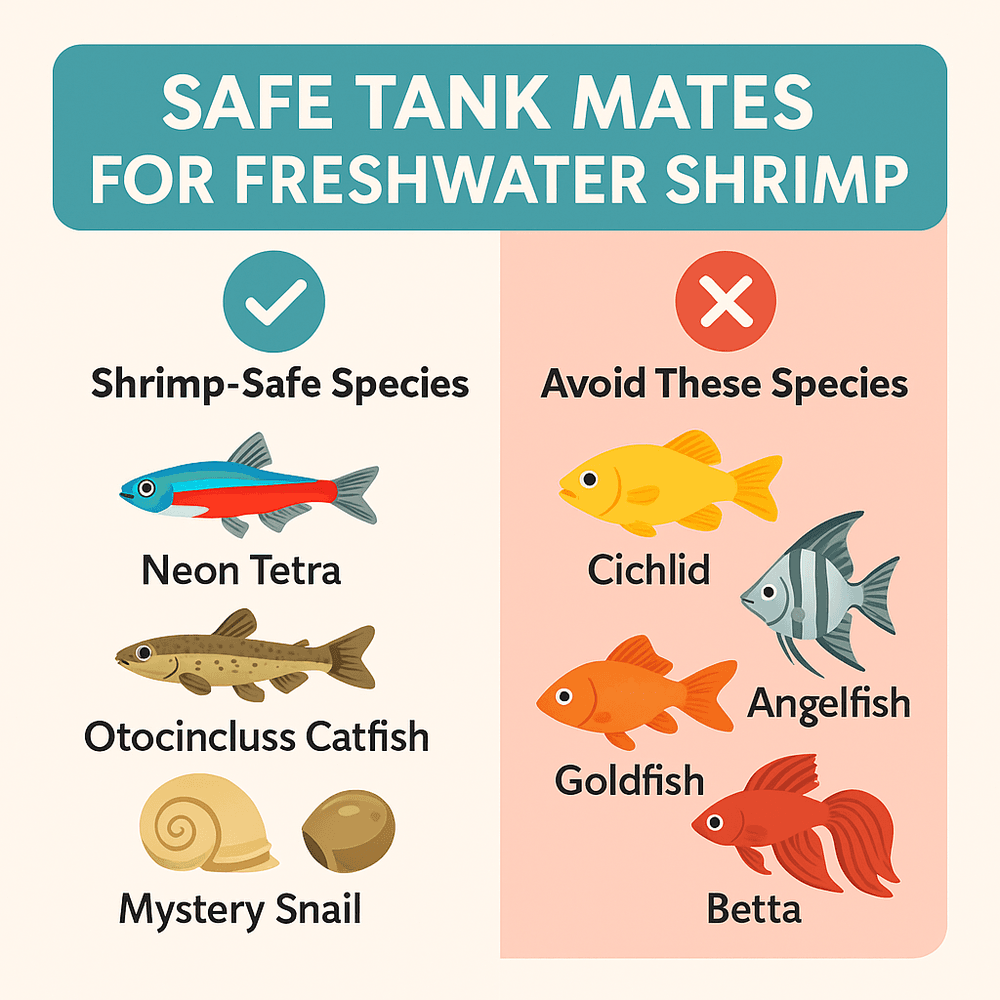
💡 Tip: Baby shrimp (shrimplets) are the most at risk. To increase survival rates, provide dense vegetation, mosses, and shrimp caves for cover. In heavily planted tanks, even with some riskier species, colonies can persist if hiding spaces are abundant.
Here’s our list of the Best Freshwater Fish for Beginners to consider as shrimp‑safe companions.
Breeding Shrimp in a Home Aquarium
Breeding freshwater shrimp can be one of the most rewarding aspects of shrimp keeping—and fortunately, it’s quite achievable in a home aquarium, especially with Neocaridina species like cherry shrimp. Under the right conditions, many shrimp will breed readily without special intervention.
For breeding to succeed, your tank must be stable, well-cycled, and predator-free. Clean water, stable parameters, and an abundance of biofilm or algae for baby shrimp to graze on are essential. Female shrimp will only carry eggs when conditions are optimal, and even small stressors like poor water quality or overcrowding can disrupt breeding cycles.
🔹 Breeding Behavior & Lifecycle
- Courtship: After a female moults, she releases pheromones that attract males.
- Berried females: Once fertilised, a female will carry eggs under her abdomen for ~2–3 weeks. These are called “berried” shrimp.
- Hatching: Baby shrimp (shrimplets) are born fully formed and begin grazing immediately. They are extremely small and vulnerable.
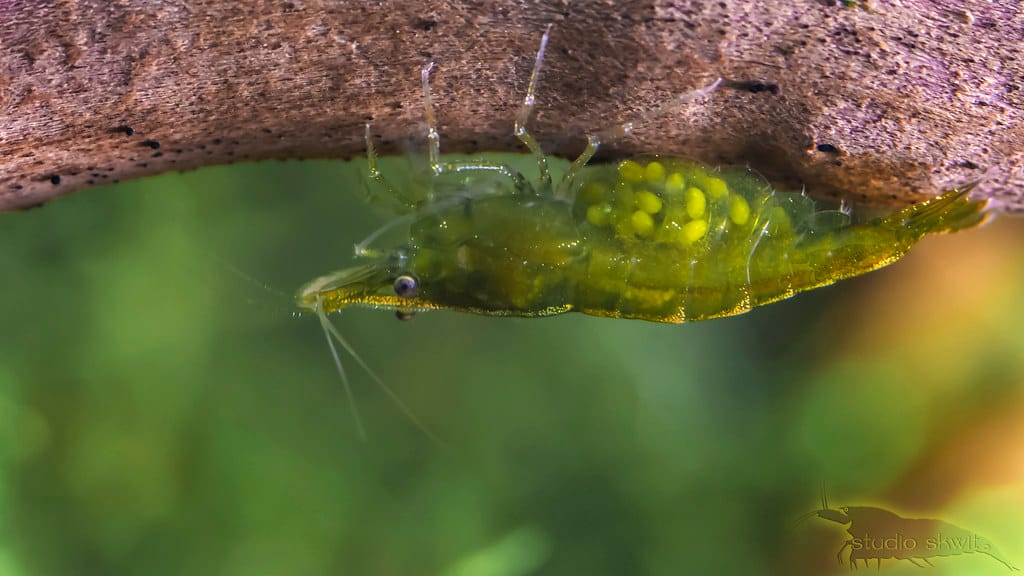
🔸 Best Setup for Breeding Shrimp
- Water Parameters: Keep everything stable—especially GH, KH, and TDS. Neocaridina are more forgiving; Caridina (e.g. Crystal Red Shrimp) require more precise conditions and softer water.
- Hiding Spaces: Use moss (like Java or Christmas Moss), dense plants, and leaf litter. These provide food and shelter for shrimplets.
- Minimal Filtration Flow: Use sponge filters or fine intake guards to avoid sucking in baby shrimp.
- No Predators: Even small fish may eat newly hatched shrimp. A shrimp-only tank gives the highest survival rate.
💡 Tip: If you want to boost your colony, feed baby shrimp with powdered or micro-sized food like shrimp-specific baby formulas, spirulina powder, or finely crushed flakes.
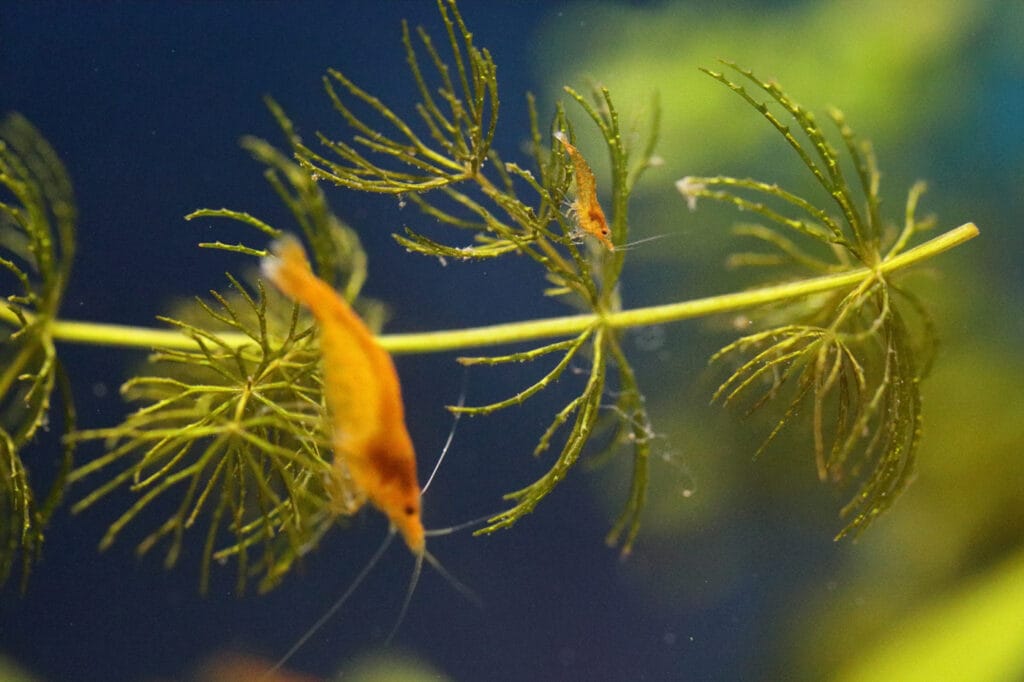
Care and Maintenance Tips
Keeping your shrimp healthy and thriving isn’t difficult, but it does require consistency and attention to detail. Poor maintenance is one of the most common causes of shrimp stress, failed moults, or population decline, so establishing a routine is key.
🔹 Weekly and Monthly Maintenance
✅ Check water parameters weekly, especially TDS, GH, KH, and nitrate levels. Use a liquid test kit or a digital TDS meter for accurate results.
✅ Top off the tank with remineralised RO/DI water to compensate for evaporation. Avoid tap water unless pre-treated and consistent, as fluctuations in hardness or pH can shock shrimp.
✅ Perform small water changes (10–20%) every 1–2 weeks. Always match the temperature and parameters of the new water to the tank. Sudden changes can cause moulting issues or death.
✅ Gently clean filter sponges in old tank water to preserve beneficial bacteria. Never rinse them under tap water.
✅ Trim overgrown plants and remove decaying leaves or leftover food to prevent ammonia spikes.
✅ Replenish calcium and minerals if GH drops too low, especially in planted tanks with active substrates.
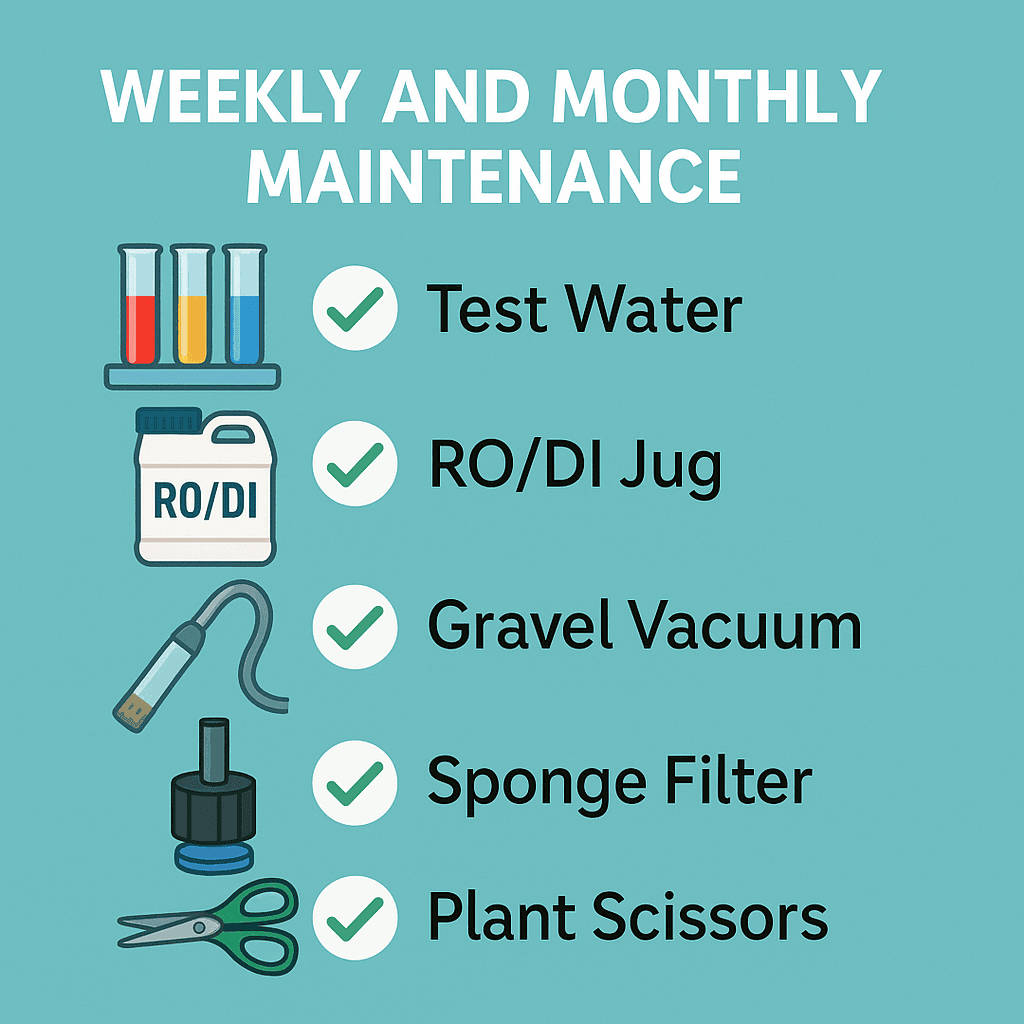
💡 Tip: Keep a shrimp care log to record parameter changes, water changes, and breeding activity. This helps spot trends and prevent issues.
Learn the best practices in our Ultimate Aquarium Maintenance Guide.
🔸 Avoiding Common Mistakes
❌ Don’t add shrimp to an uncycled tank. Wait at least 4–6 weeks after starting a new setup.
❌ Avoid copper-based medications and some fertilizers—these are lethal to shrimp. Always check product labels for copper (Cu).
❌ Don’t overfeed. Uneaten food decays quickly, leading to dangerous ammonia spikes. If in doubt, underfeed.
✅ Quarantine new plants and tank mates. Planaria, hydra, and parasites can hitchhike into your shrimp colony.
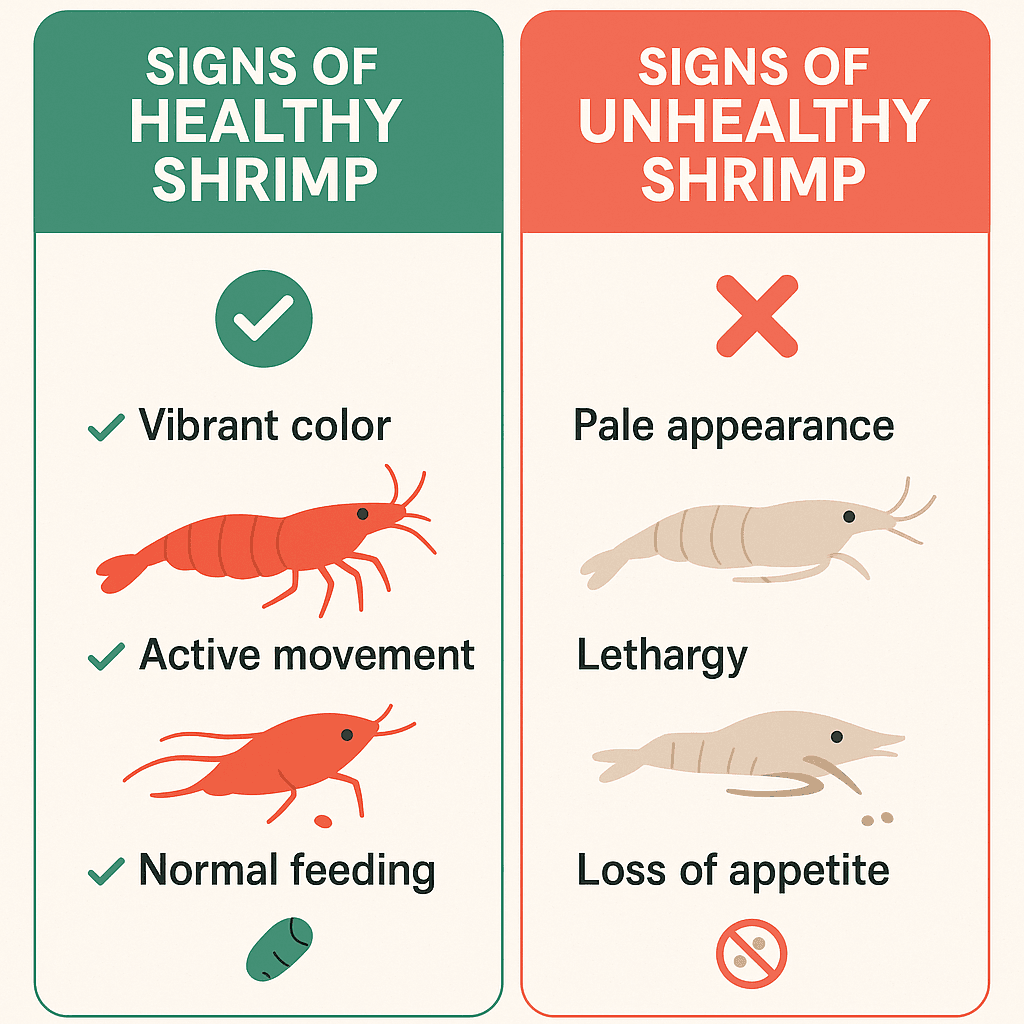
Avoid common pitfalls with help from our Beginner’s Guide to Avoiding Aquarium Mistakes.
Common Problems and Troubleshooting
Even with good care, freshwater shrimp can sometimes experience health issues. Early detection is essential—many problems can be reversed if addressed promptly.
Here are some of the most common shrimp issues and how to resolve them:
| Problem | Possible Cause | Solution |
|---|---|---|
| Shrimp not active | Poor water quality, temperature shock, or stress | Often caused by an imbalance in GH or KH levels. Stabilise water parameters. Check remineralisation routine. |
| Molting problems | Inadequate minerals (especially calcium), unstable water | Use GH+ or shrimp-specific remineralizers. Keep GH within 4–8 dGH. Avoid swings in TDS or pH. |
| White ring of death | Hiding due to stress, being eaten, and poor conditions | Often caused by an imbalance in GH or KH levels. Stabilise water parameters. Check remineralization routine. |
| Sudden death after molt | Copper contamination, ammonia spikes, or rapid TDS change | Double-check all additives for copper. Avoid large water changes. Feed less and test ammonia levels. |
| Shrimp disappearing | Sudden death after moult | Test the water immediately. Fix ammonia/nitrite issues. Ensure tank temperature is stable and within 22–26°C. Reduce disturbances. |
Additional Warning Signs
Watch for these subtle symptoms that something is off:
- Colour loss: This could indicate poor diet, stress, or unsuitable pH
- Floating moults: Normal—but if frequent with deaths, investigate mineral levels
- Rapid deaths of new shrimp: Often due to improper acclimation or “new tank syndrome”
💡 Tip: Always drip-acclimate new shrimp for 1–2 hours using airline tubing to prevent shock from parameter changes.
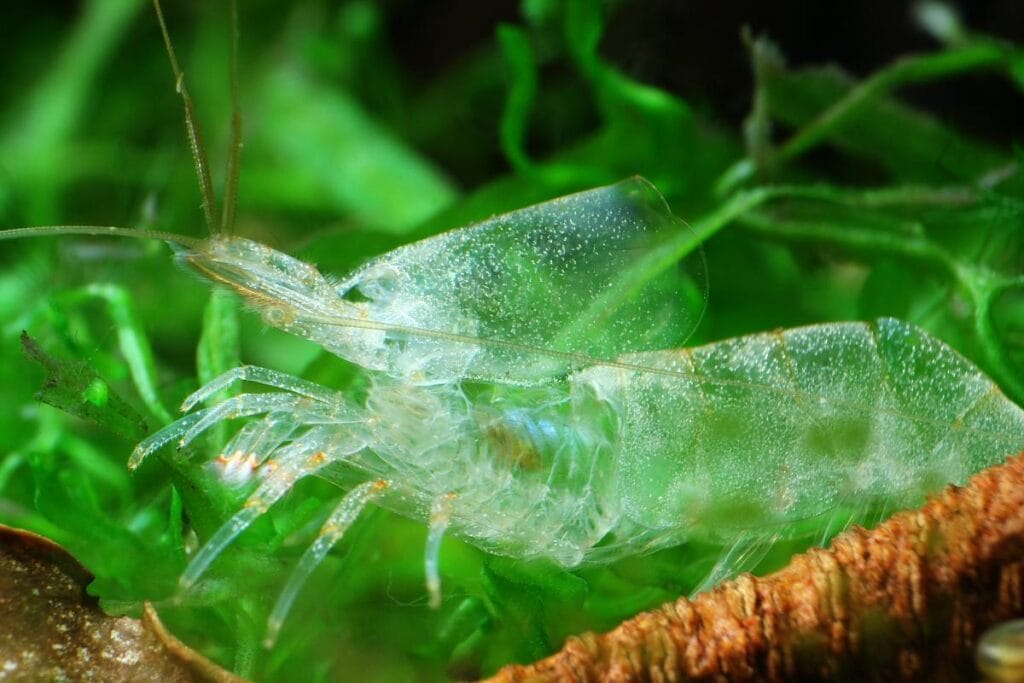
Conclusion
Freshwater shrimp are more than just beautiful invertebrates—they’re active members of a healthy aquatic ecosystem. Whether you’re caring for hardy Neocaridina like cherry shrimp or more delicate Caridina species, success comes down to stability, patience, and attention to detail.
By maintaining clean, mature water conditions and feeding a varied diet, you can enjoy a vibrant, self-sustaining shrimp colony that thrives for years. Their unique behaviours—like algae grazing, moulting, and breeding—offer endless fascination for aquarists of all levels.
To recap, here’s what makes shrimp so rewarding to keep:
🧪 Stable Water Parameters: Always test and adjust as needed. Stability is key.
🧼 Clean-Up Crew Duties: They naturally consume algae, leftover food, and detritus.
🧬 Breeding Potential: In the right conditions, colonies will reproduce with minimal intervention.
🌿 Plant-Friendly: Perfect companions for aquascaped and nano-planted tanks.
🧘 Peaceful Nature: Shrimp rarely cause trouble and blend well with calm tank mates.
Once established, shrimp tanks require minimal intervention beyond regular maintenance and observation. They’re a great entry point into the world of invertebrate keeping or a peaceful enhancement to a planted aquarium.
Whether you’re creating your first shrimp tank setup or enhancing a mature aquarium, these tiny inverts offer big rewards in beauty, behaviour, and biological balance.

